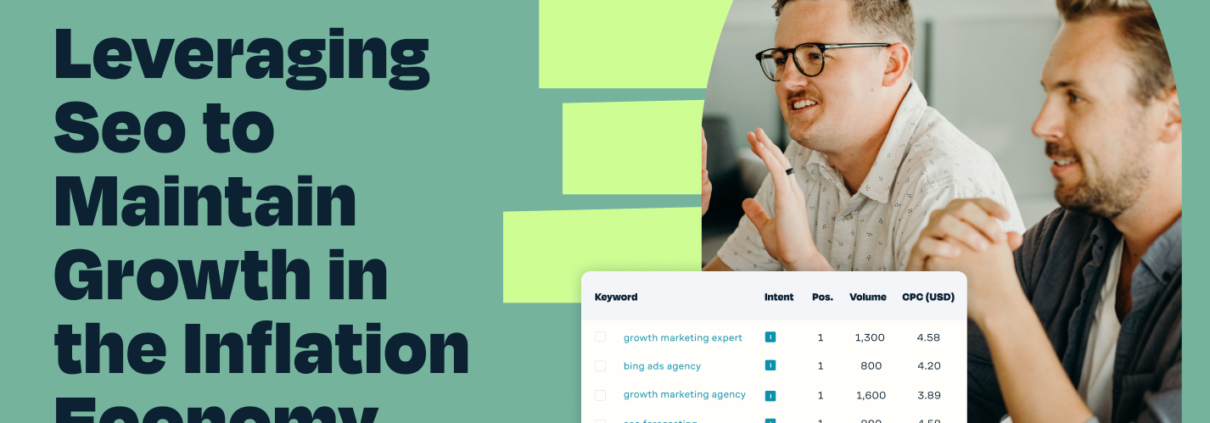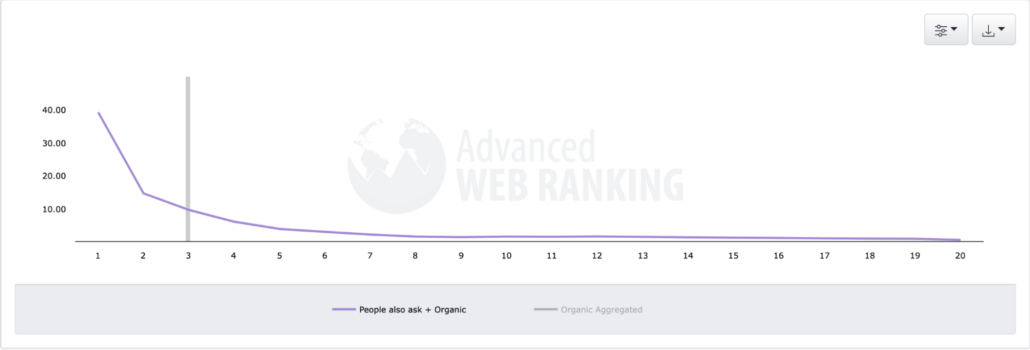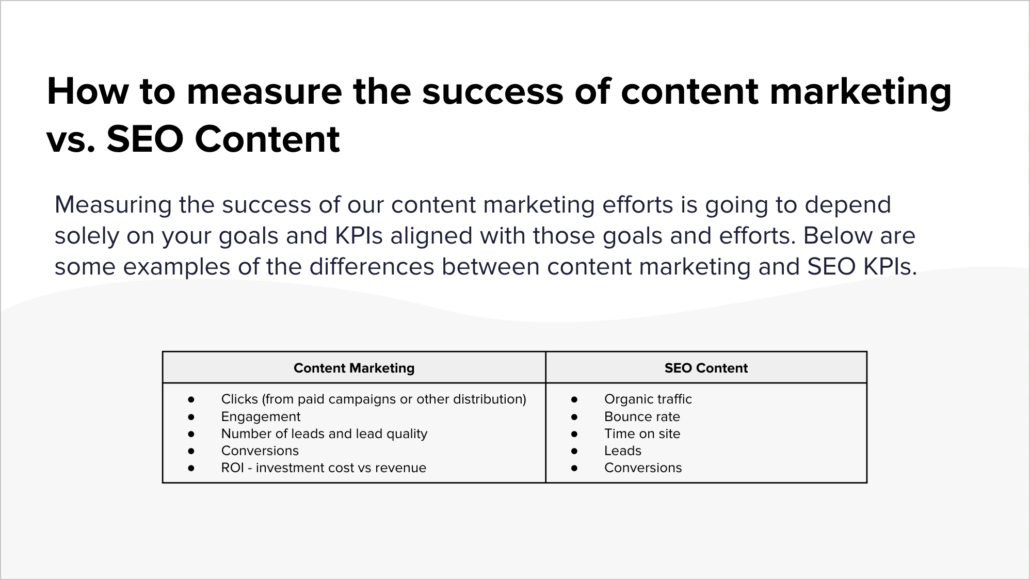Leveraging SEO to Maintain Growth in the Inflation Economy
Data-Driven SEO: 5 Data Points for Your 2023 Marketing Plans
- 88% of marketers who have an SEO strategy will increase or maintain their investment in 2023. [Source: HubSpot]
- 73% of clicks now going to organic web listings—up from 65% just last year [Source: Brightedge]
- Consumers are searching 20% more than in 2021 [Source: Brightedge]
- Organic Search Outperforms Paid Ads: Higher CTRs (27.6% vs. 3.17%) [Sources: Backlinko & WordStream]
- 82% of Customer Experience (CX) leaders expect their program budgets to rise within the next 12 months. [Source: Forrester]
Intro
In today’s inflationary economy, marketing professionals face mounting challenges as they navigate budget constraints and the pressure to deliver results. As CFOs scrutinize media budgets, the need for cost-effective marketing strategies has never been more crucial.
Enter SEO, a high-yield channel that remains relatively unaffected by market fluctuations. In fact, 88% of marketers who have an SEO strategy will increase or maintain their investment in 2023, and for good reason.
Brightedge, a leading enterprise SEO tool, data reveals that consumers are searching 20% more than in 2021, and according to Gartner, CMOs are focusing more on channels that create efficiencies – SEO is one of those channels.
With a staggering 73% of clicks now going to organic web listings—up from 65% just last year—there’s no better time for businesses to leverage the power of SEO to maintain growth and stay competitive in the face of economic uncertainty.
As a growth marketing agency, that’s exactly what Tuff is helping our partners do and I’ll explain just how in this article.
Table of contents
- The Current Marketing Landscape: Challenges and Opportunities
- Understanding SEO as a High-Yield Channel in Challenging Economic Conditions
- Building Trust with Customers through SEO
- SEO Strategies for Success in an Inflation Economy
- How to create high-quality, relevant content through audience research and persona building
- Measuring SEO and Content Marketing Success and ROI
- Key Takeaways
The Current Marketing Landscape: Challenges and Opportunities
As inflation continues to put a strain on the global economy, marketing budgets are among the first to be impacted. Companies are tightening their belts, and this puts immense pressure on CMOs to deliver results despite shrinking resources. In this environment, it is crucial for marketing leaders to not only understand the challenges posed by inflation but also recognize the opportunities that arise from focusing on the right marketing strategies.
According to data from Backlinko, the top position in Google’s organic search results receives an average click-through rate (CTR) of 27.6%. In contrast, WordStream data reveals that the average CTR for paid search ads across all industries on Google is only 3.17%.
More importantly, this trend extends beyond the top organic search result. According to Advanced Web Metrics, pages ranking in positions 1-5 in Google search results all surpass the 3.17% average CTR for paid search ads.
In this challenging economic environment, it is essential for marketing leaders to prioritize channels that provide the highest return on investment while demanding minimal additional costs. Among the various digital marketing strategies, SEO has emerged as a particularly powerful and cost-effective solution.
CMOs are increasingly focusing on SEO to drive traffic, generate leads, and achieve long-term, sustainable growth. By prioritizing SEO, businesses can tap into new customer segments and stay ahead of their competition. With the majority of consumers relying on search engines to find products and services, a strong SEO strategy becomes indispensable for maintaining visibility and capturing valuable organic traffic.
By focusing on and investing in SEO, businesses can create efficiencies, establish a strong online presence, and ultimately weather the economic storm. As a result, companies that can effectively leverage SEO will be better positioned to thrive amidst the challenges presented by the current inflationary economy.
Understanding SEO as a High-Yield Channel in Challenging Economic Conditions
SEO’s evolving role in digital marketing strategies
In the current economic climate, marketing leaders are more focused than ever on deriving maximum value from their SEO efforts. Organizations are prioritizing SEO to ensure cost-effective marketing solutions amidst budget constraints. According to HubSpot, 88% of marketers who have an SEO strategy will increase or maintain their investment in 2023.
For experienced SEO professionals, this means staying informed about the latest algorithm updates, such as the recent Google March 2023 Broad Core Update, which emphasizes the importance of experience, expertise, authoritativeness, and trustworthiness (E-E-A-T) in content.
SEOs need to be aware of changes in Google’s ranking systems, as illustrated by the removal of several search ranking algorithm updates from its ranking systems page. By staying ahead of the curve and capitalizing on emerging opportunities, marketers can maintain and improve their search engine rankings and make the most of their SEO strategies.
Adjusting organic search tactics for driving traffic and conversions
While experienced marketers recognize the importance of organic search in driving traffic and conversions, it is crucial to adjust tactics to maximize results. The SEMrush State of Content Marketing report emphasizes the need to focus on comprehensive keyword research, including long-tail keywords and semantic search optimization, to capture user intent more effectively.
In order to effectively capitalize on user intent, marketers should prioritize audience research and persona building, topic clusters, and pillar pages to create a cohesive content strategy that caters to users’ needs, pain points, and search engine preferences. By continuously adjusting organic search tactics, marketers can gain a competitive edge and drive better-qualified traffic and higher conversion rates.
Leveraging technical SEO and data-driven insights for long-term ROI
Given the potential for substantial long-term ROI with SEO, marketing leaders must continuously refine their strategies to stay ahead of the competition. The State of Technical SEO report (2023) by Search Engine Land suggests that marketers should prioritize technical optimizations, such as Core Web Vitals, structured data, and advanced schema markup, to improve their site’s visibility and user experience.
Integrating data-driven insights from analytics, user behavior analysis, and CRO can help marketers identify areas for improvement and tailor their SEO strategies for maximum impact.
Building Trust with Customers through SEO
This image was AI-generated
Creating high-quality, relevant content
The importance of high-quality, relevant content that aligns with users’ search intent and preferences, cannot be overstated. This involves developing data-driven content strategies that address user pain points, answer questions, and provide valuable insights. By consistently delivering top-notch content, marketers can position their brand as an industry authority and build trust with their target audience.
Ensuring a user-friendly website experience
A seamless and user-friendly website experience is critical in fostering trust with customers. In fact, 82% of Customer Experience (CX) leaders, surveyed by Forrester, expect their program budgets to rise within the next 12 months. Technical aspects, such as site speed, mobile-friendliness, and accessibility, play a significant role in customer experience. By prioritizing these factors and implementing best practices, marketers can reduce bounce rates, improve engagement, and enhance overall customer satisfaction.
Developing a strong brand presence and reputation online
The impact of trust on customer lifetime value (LTV) and retention
Building trust with customers through effective SEO strategies can significantly impact customer lifetime value (LTV) and retention. When customers perceive a brand as trustworthy and authoritative, they are more likely to become repeat customers and recommend the brand to others. Marketers should focus on continuously refining SEO efforts to maintain customer trust, which in turn leads to increased loyalty, positive word-of-mouth, and long-term revenue growth.
SEO Strategies for Success in an Inflation Economy
Embracing the shift towards user-centric SEO
This Forrester report highlights the evolution of search marketing towards a more user-centric approach. To succeed in an inflation economy, marketers should prioritize user intent, experience, and satisfaction in their SEO strategies. This involves analyzing user behavior, search patterns, and feedback to create content and optimize website elements that cater to users’ needs and expectations. By embracing user-centric SEO, marketers can drive more targeted traffic and improve conversion rates.
Leveraging AI and automation for efficiency and scale
Incorporating AI and automation into SEO strategies can help drive efficiency and scale. Businesses can capitalize on AI-powered tools and platforms to automate tasks like keyword research, content optimization, and competitor analysis. By streamlining these processes, marketing professionals can save time and resources, allowing them to focus on strategic decision-making and long-term growth initiatives.
Integrating SEO with content marketing and PR efforts
The economic downturn and shift in marketing strategies emphasizes the need for marketers to break down silos and integrate SEO with content marketing and PR efforts. By aligning these disciplines, businesses can create cohesive, consistent messaging that strengthens their brand presence and authority in organic search. Collaborating with content creators, PR, PPC, and CRO can help marketers amplify their reach, improve backlink profiles, and drive higher levels of engagement.
Adapting to SERP changes and emerging trends
The ever-changing landscape of search engine results pages (SERPs) presents both challenges and opportunities for marketers. Businesses need to stay informed about SERP changes, algorithm updates, and emerging trends, such as voice search, AI chat responses, and visual search optimization. By adapting to these developments and incorporating them into their SEO strategies, marketers can maintain a competitive edge and continue to drive growth in the inflation economy.
How to create high-quality, relevant content through audience research and persona building
Audience research
This image was AI-generated
To create truly engaging content that resonates with your audience, it’s essential to have a deep understanding of who they are and what they care about. Incorporating audience research into your content creation strategy can help you better tailor your messaging and ensure your efforts hit the mark. Here are some steps to help you connect with your audience on a deeper level:
- Dig into Customer Data – Kick things off by examining your existing customer data for insights about your audience, such as demographics, behavior, and preferences. This might include information from customer databases, CRM systems, or website analytics.
- Get Personal with Surveys and Interviews – Engage your target audience through surveys or interviews to learn about their needs, motivations, and pain points. If you’ve already done this, review any internal data you have, like customer support logs or sales data, for additional insights.
- Chat with Sales and Customer Service Teams – Connect with your sales and customer service teams to gather feedback on customer interactions and identify common questions or issues customers face. This can help you better understand your audience’s needs.
- Explore Social Media and Online Communities – Investigate social media channels, forums, reviews, and online communities where your audience engages to uncover insights into their behavior, preferences, and opinions. This will help you understand how your audience interacts with your brand and related topics.
- Pinpoint Audience Segments and Priorities – Use the insights you’ve gathered to identify audience segments and prioritize them based on their value to your business. Consider factors like profitability, growth potential, and ease of reaching them.
- Craft Detailed Personas – Create detailed personas representing each audience segment, including demographics, behavior patterns, and pain points. Use a template to structure your personas and add realistic details for accuracy.
- Validate and Refine Personas – Share your personas with stakeholders, conduct additional research, or test them with your audience to validate their accuracy. Refine your personas based on feedback and new insights to ensure they truly represent your audience.
- Apply Personas to Marketing Strategies – Leverage your personas to guide your marketing strategies, including messaging, content creation, and campaigns. Develop targeted content and messaging that resonates with your audience segments and aligns with their needs and preferences.
Persona building
This image was AI-generated
Building detailed customer personas is crucial for creating targeted content that resonates with your audience. When developing customer personas, try to include the following elements:
Demographics:
- Age
- Gender
- Income level
- Education level
- Occupation
- Location (urban, suburban, rural, region, country)
Psychographics:
- Values
- Beliefs
- Attitudes
- Lifestyle
- Interests
- Hobbies
- Personal goals
- Aspirations
Behavioral Patterns:
- Purchasing habits
- Online browsing behavior
- Social media usage
- Preferred communication channels (email, social media, phone, etc.)
- Brand loyalty and preferences
- Customer journey stages
- Pain points and challenges
- Decision-making criteria
Online Presence:
- Preferred social media platforms
- Online communities or forums they participate in
- Influencers they follow
- Blogs or websites they frequent
- Types of content they consume and share (articles, videos, podcasts, etc.)
Emotional Triggers:
- Fears
- Desires
- Motivations
- Emotional needs
- Anxieties
- Expectations
The Problem or Need:
- Specific problems they’re trying to solve
- Needs that your product or service can fulfill
- Gaps in their current solutions
Unique Selling Proposition (USP):
- How your product or service stands out from competitors
- The benefits your product or service provides to the persona
- What makes your brand the ideal choice for them
Quotes and Testimonials:
- Actual quotes from customers or prospects that embody the persona
- Testimonials that demonstrate the success stories of customers similar to the persona
Persona Name and Visual Representation:
- Assign a name to each persona for easy reference
- Create a visual representation (e.g., stock photo, illustration) to bring the persona to life
Segment-Specific Considerations:
- Industry or niche-specific factors
- Cultural or regional differences
- Any other unique characteristics relevant to your target audience
By incorporating these elements into customer personas, you can create a comprehensive and accurate representation of your target audience. This allows you to craft content and marketing strategies that effectively resonate with each persona, leading to higher engagement and conversion rates.
Measuring SEO and Content Marketing Success and ROI
As experienced marketers, you understand the importance of demonstrating the value and ROI of your SEO and content marketing efforts. To effectively measure success, it’s crucial to establish a data-driven approach that goes beyond surface-level metrics. Here’s how you can achieve this:
- Set Clear Goals and KPIs – Start by establishing well-defined, SMART (Specific, Measurable, Achievable, Relevant, Time-bound) goals for your SEO and content marketing campaigns. Align these goals with your organization’s overall objectives, and then determine the KPIs that will help you gauge progress. For instance, you might choose to measure organic traffic growth, keyword ranking improvements, the number of leads generated from organic search, or impact on customer LTV.
- Leverage Attribution Models – Adopt a comprehensive attribution model, such as data-driven or multi-touch attribution, to gain a better understanding of how SEO and content marketing contribute to customer acquisition and revenue generation. This will help you allocate resources more effectively and prioritize high-impact strategies.
- Integrate SEO and Content Data – Integrate your SEO and content marketing data with other marketing and sales platforms, such as CRM and marketing automation systems. This enables a unified view of your customers’ journey, providing valuable insights into how SEO and content marketing impact lead nurturing, conversion, and customer retention.
- Implement A/B Testing and Iteration – Utilize A/B testing to refine your SEO and content marketing strategies. By experimenting with different approaches, such as content formats, headlines, and calls-to-action (CTAs), you can identify the tactics that resonate best with your audience and generate the highest ROI.
- Establish a Continuous Improvement Process – Create a culture of continuous improvement by regularly reviewing your KPIs, analyzing performance data, and adjusting your strategies accordingly. This will enable you to stay ahead of industry trends, capitalize on emerging opportunities, and maximize the ROI of your SEO and content marketing efforts.
Key Takeaways
In conclusion, the current economic uncertainty demands marketing leaders to be more strategic in their approach. As experienced professionals, you understand the importance of SEO in maintaining growth and driving cost-effective results.
By leveraging advanced SEO tactics and focusing on long-term ROI, you can not only weather the storm but also strengthen your brand’s online presence and improve customer LTV. As you navigate these challenging times, remember that a robust and data-driven SEO strategy is an essential component of your marketing arsenal.
By staying agile, optimizing your approach, and capitalizing on emerging opportunities, you can continue to drive significant value and growth for your organization, even in the most volatile market conditions.

Derek is a digital marketer based in Boston, Massachusetts with almost a decade of hands-on SEO experience. He finds it meaningful, challenging, and exciting to develop, test, and implement new SEO strategies. When he’s not auditing websites and optimizing content he’s usually backpacking and exploring new cultures.













